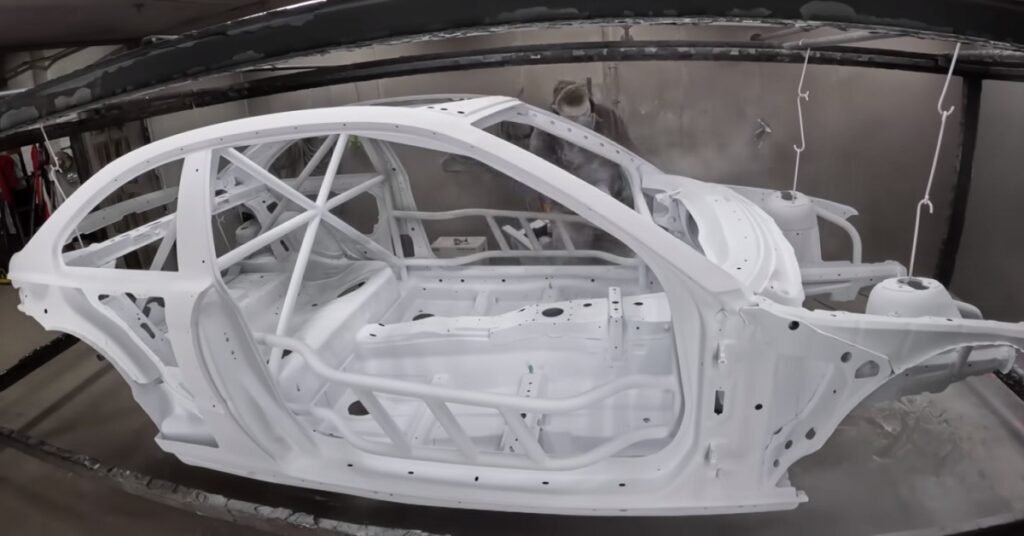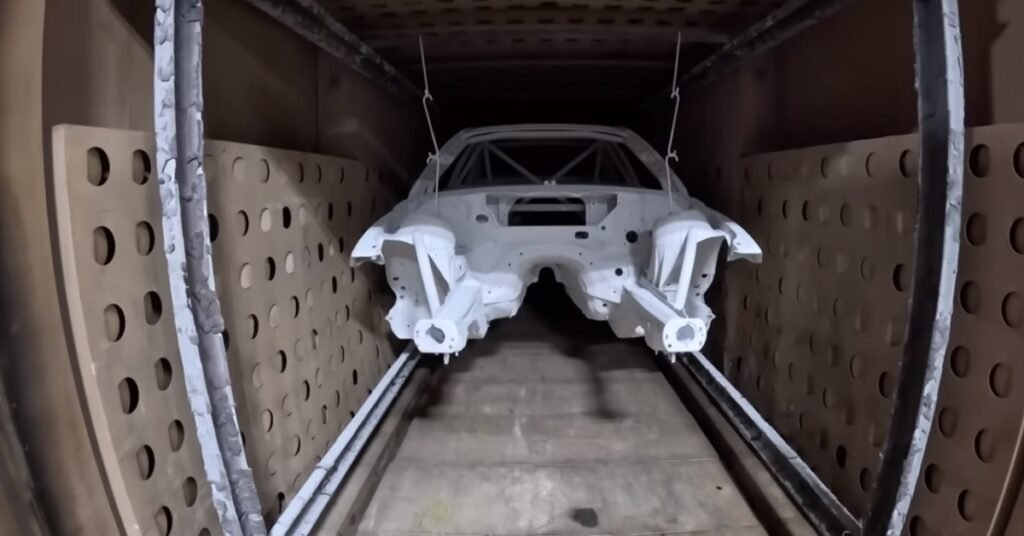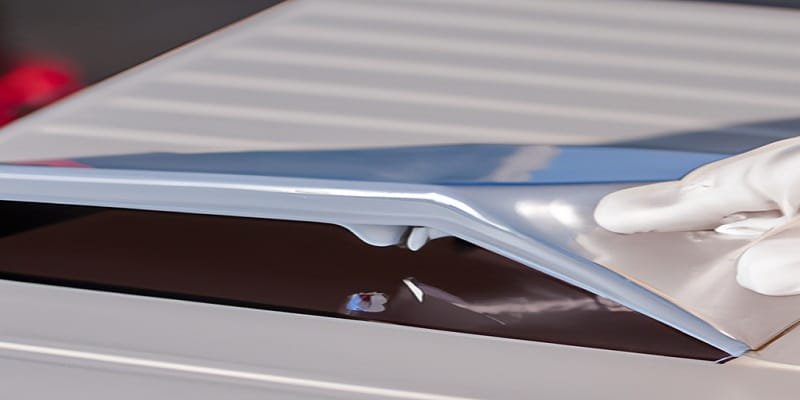Have you ever seen a tricked out hot rod or custom car with a super glossy, flawless finish and wondered how they achieved that liquid-smooth look? Odds are it wasn’t traditional paint giving that car its slick coat—it was powder coating.
Powder coating has become the go-to for custom automotive paint jobs, offering a durable, high-gloss and scratch-resistant finish that far outlasts conventional spray paint. But can you powder coat an entire car, or is it only practical for parts and pieces? Let’s dive in and find out.

Is Powder Coating an Entire Car Possible?
Powder coating a whole car is definitely possible, but it’s a much more extensive process compared to coating just parts or components.
Here’s what’s involved in taking your ride’s finish to the next level with a full-body powder coat:
Prep Work is Key
Before any powder gets sprayed, there’s extensive prep work required to get the car down to bare metal. All existing paint has to be completely stripped through sand blasting or chemical stripping. Any dents or rust spots need to be repaired and smoothed out. Then the entire surface needs to be meticulously sanded and cleaned prior to coating. Masking off sections not intended for coating, like glass and rubber seals, takes time too.
With the right equipment and patient technicians, this prep work can be accomplished for an entire car, but it’s labour intensive. Some shops outsource stripping and sanding due to the effort involved. Proper prep is crucial though, or the powder coat won’t adhere correctly.
Every Nook and Cranny Needs Coating
When coating just parts or panels, technicians can dismantle components and coat all surfaces. But for a whole car exterior, getting an even coat of powder in every crack and crevice while avoiding overspray is an art form. Special attention needs to be paid to hard-to-reach areas like door jambs and trunk welds. Masking techniques and powder spray guns that can reach tight spots are must-haves for high-quality full car powder coating.
Curing Powder Coat Takes High Heat
Following application, powder coated parts are typically cured in an industrial oven. But few ovens are big enough to accommodate an entire car! So shops need specialty infrared heating lamps or makeshift ovens to properly cure the powder coat on a whole car. This equipment represents a significant investment. For large vehicles, technicians may need to cure sections individually. If the coat isn’t evenly cured, results will be compromised.
Advantages Of Using Powder Coating On Cars
Powder coating offers several advantages over traditional paint finishes for cars. Here are some key benefits:
Durability: Powder coating provides a tough and resistant finish that can withstand the rigors of daily use. It is less prone to chipping, scratching, and fading compared to conventional paints.
Attractive finish: Powder coating offers a smooth and even finish, providing a high-quality appearance to your car. With a wide range of colors and finishes available, you can customize the look of your vehicle to suit your personal style.
Protection: The powder coating acts as a protective barrier, shielding your car’s surfaces from environmental elements such as UV rays, moisture, and chemicals.
Environmental friendliness: Unlike traditional liquid paints, powder coatings do not contain harmful solvents and emit negligible volatile organic compounds (VOCs). This makes powder coating a more eco-friendly option for car enthusiasts.
What to Consider Before Powder Coat a Whole Car
Deciding to powder coat your car rather than a traditional paint job is just the first step. Here’s what to keep in mind before pulling the trigger:
Masking and Dismantling Required
To properly coat the entire exterior, you’ll need to remove or mask off all trim pieces, lights, windows, etc. For hard-to-reach areas like door jambs and trunk welds, you’ll need to get creative with masking techniques. This alone can add hours of labor to the process.
Curing an Entire Car Takes Serious Heat
When powder coating parts, small batches can be cured in an oven. But for a whole car? You’ll likely need infrared lamps or a makeshift oven to properly cure the coat after application. This specialty equipment can get costly.
Meticulous Washing and Maintenance is a Must
While powder coating is more durable than paint, it’s not indestructible. Just like a conventional paint job, regular washing and maintenance is required to keep that showroom shine. Minor rock chips and flaws in the coating can lead to oxidation and rust if left untreated. Being meticulous about upkeep is essential.
Cost Can Get Prohibitive for Full Coating
Between the extensive labor involved and equipment needed, powder coating an entire car gets expensive in a hurry. It can easily cost $3000-$6000 or more for a high-quality full powder coat job. Larger vehicles will be at the higher end of that range. While the results may be spectacular, it’s not exactly an affordable option for most.
With these considerations in mind, powder coating can be a fantastic option for giving your car a fresh and long-lasting finish. Ensure you do thorough research and consult with professionals to make an informed decision for your prized possession.
Preparing Your Car For Powder Coating

Proper Cleaning And Preparation Before Powder Coating
Before you can take your car to the next level with a fresh powder coat finish, it is crucial to properly clean and prepare the vehicle. This preparation ensures that the powder coating adheres smoothly and flawlessly, resulting in a beautiful and long-lasting finish.
To start, you should give your car a thorough washing. Use a gentle automotive soap and a soft sponge to remove any dirt, grime, or grease from the surface. Pay close attention to hard-to-reach areas, such as the wheel wells and undercarriage, as these can harbor debris that may interfere with the powder coating process.
Key Steps:
- Begin by washing your car thoroughly with a gentle automotive soap and a soft sponge.
- Pay close attention to hard-to-reach areas, such as the wheel wells and undercarriage.
Steps Involved In Preparing A Car For Powder Coating
Once your car is clean, it’s time to move on to the next steps involved in preparing it for powder coating. The process might seem daunting, but by following specific procedures, you can ensure a successful and professional-looking result.
Firstly, you’ll want to remove any components that are not meant to be powder coated, such as rubber seals, plastic trim, and any removable parts like bumpers or mirrors. This step will allow you to have full access to the bodywork and ensure an even coating throughout the entire surface.
Secondly, make sure to mask off any sensitive areas that should not be powder coated. This includes areas like windows, headlights, and any other parts that could be damaged by the high heat of the curing process.
Key Steps:
- Remove any components that are not meant to be powder coated, such as rubber seals, plastic trim, and removable parts like bumpers or mirrors.
- Mask off any sensitive areas that should not be powder coated, such as windows and headlights.
Importance Of Surface Preparation For A Successful Powder Coating
Proper surface preparation is vital when it comes to achieving a successful powder coating for your car. It sets the foundation for a durable, flawless finish that will withstand the test of time.
One of the primary reasons why surface preparation is so important is that it ensures the proper adhesion of the powder coating to the car’s surface. Any residue, dirt, or imperfections left on the surface can create bond issues, resulting in a less durable finish or even coating failure.
Additionally, surface preparation helps to remove old paint, rust, or corrosion that may be present on the car’s body. By eliminating these imperfections, you create a smooth and clean surface for the powder coating to adhere to, preventing any future issues.
Key Points:
- Proper surface preparation ensures the proper adhesion of the powder coating.
- It helps to remove old paint, rust, or corrosion from the car’s body.
The Powder Coating Process For Cars
When it comes to giving your car a fresh, vibrant look that lasts, powder coating is a game-changer. This state-of-the-art process not only enhances the appearance of your vehicle but also provides unmatched durability and protection against harsh elements.
Introduction To The Powder Coating Process
Unlike traditional paint methods, powder coating involves the application of dry powder to the car’s surface. The powder is electrostatically charged to adhere to the metal and is then cured under heat to create a smooth, flawless finish. With its wide range of colors and finishes, powder coating allows you to personalize your car’s appearance and ensure it stands out from the crowd.

Steps Involved In Powder Coating A Car
The process of powder coating a car can be divided into several key steps that guarantee a professional and long-lasting result:
Surface Preparation: To ensure proper adhesion, the surface of the car must be thoroughly cleaned and stripped of any existing paint, rust, or debris. This is typically achieved through sandblasting or chemical stripping.
Masking: Areas that should not be coated, such as windows or trim, are carefully masked off to protect them from the powder.
Priming: A layer of primer is applied to the car’s surface to enhance adhesion and promote a smooth finish.
Application: The charged powder is sprayed onto the car using specialized equipment, evenly coating the entire surface with precision.
Curing: The coated car is then baked in an oven at 375 degree for 30 minutes. The heat causes the powder to melt and fuse into a durable coating, ensuring maximum strength and resistance to scratches, chips, and fading.
Techniques And Equipment Used For Powder Coating
To achieve outstanding results, skilled technicians rely on various techniques and equipment tailored specifically for powder coating:
| Technique | Description |
|---|---|
| Electrostatic Spray | An electrostatically charged gun is used to apply the powder, ensuring efficient and controlled coverage. |
| Tribo-Charging | This technique utilizes friction to charge the powder particles, allowing for enhanced transfer efficiency and a smoother finish. |
| Fluidized Bed | In this method, the car part is preheated and immersed in a fluidized bed of powder, achieving a thick and even coating. |
As for equipment, specialized powder coating booths and ovens provide a controlled environment for the process, ensuring optimal curing temperatures and proper ventilation. These tools, combined with the expertise of skilled professionals, guarantee a flawless finish that will make your car truly stand out.
Aftercare And Maintenance For Powder Coated Cars
So, you’ve decided to give your car the impeccable finish of a powder coating. Congratulations! Powder coating not only enhances the appearance of your vehicle but also provides a durable and long-lasting finish that can withstand the tests of time. However, like any other type of automotive coating, proper aftercare and maintenance are crucial to preserve the beauty and integrity of the powder-coated surface.
In this section, we will explore some essential tips for maintaining a powder coated car, common issues that may arise, and troubleshooting solutions to keep your car’s powder coating looking flawless.
We will also delve into the longevity and durability of powder-coated cars, revealing how this type of coating can keep your car stunning for years to come.
Tips For Maintaining A Powder Coated Car
To ensure your powder coated car stays in top condition, incorporating these maintenance tips into your routine is essential:
Regular washing: Wash your car regularly using a mild car wash soap and a soft sponge or microfiber cloth. Avoid using abrasive cleaners, harsh chemicals, or stiff brushes, as they can damage the powder coating.
Keep it dry: After washing, thoroughly dry your car to prevent water spots. Moisture, especially when left unattended, can lead to corrosion and compromise the powder coating.
Waxing and polishing: Apply a high-quality automotive wax or polish to protect the powder coating and enhance its shine. Be sure to choose products that are safe for use on powder-coated surfaces.
Protective measures: When parking your car, try to avoid areas exposed to direct sunlight for extended periods, as UV rays can fade the powder coating over time. Additionally, consider using a car cover to protect your vehicle from the elements.
Regular inspection: Take the time to inspect your car’s powder coating for any scratches, chips, or signs of wear. Promptly addressing any issues can prevent them from escalating and extend the lifespan of the coating.
Common Issues And How To Troubleshoot Them
While powder coating is durable, it is not entirely immune to potential issues. Understanding common problems that may occur and how to troubleshoot them can help you maintain the condition of your powder coated car:
| Common Issues | Troubleshooting |
|---|---|
| Scratches or chips | Repair minor scratches or chips by applying touch-up paint specifically designed for powder coated surfaces. For larger damages, consult a professional for proper refinishing. |
| Fading or discoloration | Protect your car from excessive sun exposure and use automotive products with UV protection to prevent fading or discoloration. In case of minor fading, applying a UV-protective clear coat can help restore the color. |
| Corrosion | If you notice any signs of corrosion, immediately clean the affected area and apply a corrosion-resistant primer or topcoat to prevent further damage. |
Longevity And Durability Of Powder Coated Cars
Powder coated cars are known for their exceptional longevity and durability. This type of coating provides a tough and resilient protective layer that can outlast traditional paint finishes. With proper care and maintenance, powder coated cars can retain their beauty and protect your vehicle from various environmental factors for years on end. The combination of electrostatically applied powder particles and the curing process creates a strong bond that resists chipping, cracking, and fading.
It’s important to note that the longevity of the powder coating will also depend on the quality of the application and the skill of the professional who performs the process. Choosing a reputable and experienced powder coating technician is paramount to ensuring the longevity and durability of your car’s powder coating.
Frequently Asked Questions Of Can You Powder Coat A Car?
Is Powder Coating Better Than Paint For Cars?
Yes, powder coating is better than paint for cars. It offers stronger protection, better durability, and a more uniform finish. It also resists chips, scratches, and fading, making it a popular choice for car owners.
How Long Does Powder Coating Last On A Car?
Powder coating on a car typically lasts for many years, thanks to its durable and resilient nature. With proper care and maintenance, the coating can provide protection against rust, fading, and chipping. Its longevity depends on variables such as climate and usage.
What Can You Powder Coat On A Vehicle?
You can powder coat various parts of a vehicle, including the frame, wheels, bumpers, and trim. Powder coating provides a durable and attractive finish that is resistant to chipping and fading. It can be done on both new and old vehicles to enhance their appearance and protect them from the elements.
Is It Ok To Powder Coat Over Paint?
Yes, it is possible to powder coat over paint. However, the paint must be thoroughly cleaned and stripped before the powder coating process. This ensures proper adhesion and a smooth finish.
Final Thoughts
For car enthusiasts with custom or classic vehicles looking for an ultra-glossy, head-turning finish, powder coating offers an enticing alternative to traditional spray painting. But is powder coating an entire car rather than just components worth the effort and expense involved? For those dead set on the most stunning, durable bespoke finish money can buy, the answer may be yes.
For the rest of us, powder coating select parts and pieces may be the best route to add style and protection without breaking the bank. Either way, powder coating can take your ride’s aesthetic to the next level if you’re willing to put in the work.


